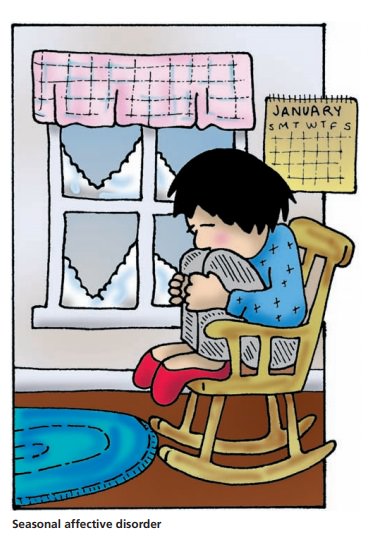Chapter: Psychiatric Mental Health Nursing : Mood Disorders
Related Disorders - Mood Disorders
RELATED DISORDERS
Other disorders classified in the Diagnostic and Statistical Manual of Mental Disorders, 4th edition,
Text Revision (APA,2000) as mood disorders but with symptoms that are less
severe or of shorter duration include the following:
·
Dysthymic disorder is characterized by at least 2 years of
depressed mood for more days than not with some additional, less severe
symptoms that do not meet the criteria for a major depressive episode.
·
Cyclothymic disorder is characterized by 2 years of numerous
periods of both hypomanic symptoms that do not meet the criteria for bipolar
disorder.
·
Substance-induced mood disorder is characterized by a prominent and
persistent disturbance in mood that is judged to be a direct physiologic
consequence of ingested substances such as alcohol, other drugs, or toxins.
·
Mood disorder due to a general medical condition is characterized
by a prominent and persistent distur-bance in mood that is judged to be a
direct physiologic consequence of a medical condition such as degenera-tive
neurologic conditions, cerebrovascular disease, metabolic or endocrine
conditions, autoimmune disor-ders, human immunodeficiency virus (HIV)
infections, or certain cancers.

Other disorders that involve changes in mood include the following:
· Seasonal affective disorder
(SAD) has two subtypes. In one,
most commonly called winter depression or fall-onset SAD, people experience
increased sleep, appetite, and carbohydrate cravings; weight gain;
interpersonal conflict; irritability; and heaviness in the extremities
beginning in late autumn and abating in spring and summer. The other subtype,
called spring-onset SAD, is less common, with symptoms of insomnia, weight
loss, and poor appetite lasting from late spring or early sum-mer until early
fall. SAD is often treated with light ther-apy (Rastad, Ulfberg, &
Lindberg, 2008).
·
Postpartum or “maternity” blues are a frequent normal experience
after delivery of a baby. They are character-ized by labile mood and affect,
crying spells, sadness, insomnia, and anxiety. Symptoms begin approximately 1
day after delivery, usually peak in 3 to 7 days, and sub-side rapidly with no
medical treatment (Sit, Rothschild, & Wisner, 2006).
·
Postpartum depression meets all the criteria for a major depressive
episode, with onset within 4 weeks of delivery.
·
Postpartum psychosis is a psychotic episode develop-ing within 3
weeks of delivery and beginning with fa-tigue, sadness, emotional lability,
poor memory, and confusion and progressing to delusions, hallucinations, poor
insight and judgment, and loss of contact with re-ality. This medical emergency
requires immediate treat-ment (Sit et al., 2006).
Related Topics